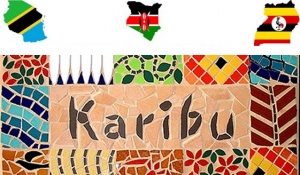Language/Swahili-individual-language/Culture/Visual-Arts
| ◀️ Oral Narratives — Previous Lesson | Next Lesson — Contemporary Literature ▶️ |
As a Swahili language teacher for over 20 years, I have had the immense privilege of not only teaching the language, but also the culture that surrounds it. In this lesson, we will delve into the rich tradition of Swahili visual arts, including painting, sculpture, and architecture. From the intricate carvings of Zanzibari doors to the vibrant colors of Tingatinga paintings, Swahili art has a unique and fascinating history that reflects the diverse influences of the East African coast.
After mastering this lesson, these related pages might interest you: Sherehe za Mapinduzi & History of Swahili.
Swahili Painting
Swahili painting has a long and varied history, with influences ranging from traditional Islamic art to contemporary Western styles. However, one of the most famous styles of Swahili painting is Tingatinga, which originated in Tanzania in the 1960s. Tingatinga paintings are known for their bright colors, bold lines, and whimsical depictions of wildlife and everyday life. The style was named after its founder, Edward Said Tingatinga, who began selling his paintings in the streets of Dar es Salaam in the 1960s.
Tingatinga paintings often feature scenes from daily life in Tanzania, such as women carrying baskets or children playing with animals. They also depict African wildlife, including elephants, giraffes, and lions. Many of the paintings have a childlike quality to them, with simple shapes and patterns used to create vibrant, playful scenes.
Another form of Swahili painting is known as "wasanii," which means "artists" in Swahili. Wasanii paintings are often more realistic and show scenes from everyday life, such as vendors selling produce or people going about their daily routines. Like Tingatinga paintings, wasanii paintings often feature bright colors and bold lines.
Swahili Sculpture
Swahili sculpture is perhaps best known for its intricate carvings on wooden doors and furniture. The art of wooden carving has been practiced in the region for centuries, and Swahili craftsmen are renowned for their skill and precision.
One of the most famous examples of Swahili sculpture is the Zanzibari door. These doors are elaborately carved with intricate motifs and designs, often featuring Islamic calligraphy, floral patterns, or depictions of animals. The doors were an important symbol of wealth and status, with wealthier families commissioning larger and more elaborate designs.
In addition to wooden carvings, Swahili sculpture also includes the art of soapstone carving. Soapstone is a soft, easily carvable stone found in many parts of East Africa. Swahili soapstone carvers use traditional techniques to create sculptures of animals, human figures, and abstract shapes. These sculptures are often highly polished, giving them a smooth, sleek appearance.
Swahili Architecture
Swahili architecture is characterized by its use of coral stone and intricate carving. Many Swahili buildings, such as the famous Lamu Fort in Kenya, were constructed using coral stone, a material found in abundance along the East African coast. Coral stone is highly durable and has a distinctive light-brown color that is synonymous with Swahili architecture.
Swahili buildings also feature intricate carvings and decorations, often in the form of Islamic calligraphy or geometric patterns. One of the most famous examples of Swahili architecture is the Gede Ruins in Kenya, an ancient Swahili city that features towering pillars, intricate archways, and delicate carvings. The city was abandoned in the 17th century and has since been reclaimed by nature, but its ruins remain an important example of Swahili architectural history.
Whether it's a Tingatinga painting, a Zanzibari door, or an ancient Swahili city, Swahili visual arts offer a fascinating glimpse into the culture and history of East Africa. By exploring these traditions, we gain a deeper understanding and appreciation of the beauty and diversity of the Swahili people.
| Swahili (individual language) | Pronunciation | English |
|---|---|---|
| Tingatinga | [tiŋɡa'tiŋɡa] | Style of Swahili painting known for its bright colors and whimsical scenes of African life and wildlife. |
| Wasanii | [wa'saːnii] | Swahili term for "artists," often used to describe a more realistic form of Swahili painting. |
| Zanzibari door | [zanzi'baːri doːr] | Highly decorated wooden door often featuring Arabic calligraphy or depictions of animals or floral patterns. |
| Coral stone | ['kɔrəl stoʊn] | Durable stone material found along the East African coast and used in Swahili architecture. |
| Gede Ruins | ['ɡeɪdi 'ruːənz] | Ancient Swahili city in Kenya featuring towering pillars, archways, and intricate carvings. |
- Tingatinga paintings are known for their bright colors and playful depictions of everyday life and wildlife.
- Swahili sculptors use intricate carvings on wooden doors and soapstone to create intricate designs.
- Swahili architecture is characterized by the use of coral stone and the incorporation of Islamic calligraphy and geometric patterns.
- Swahili art has a rich and varied history, influenced by a range of cultures and traditions.
- Tingatinga paintings are a popular form of Swahili painting known for their bright colors and whimsical scenes.
- Swahili sculptors are skilled at intricate carvings on wooden doors and soapstone.
- Swahili architecture uses coral stone and elaborate decorations to create stunning buildings and structures.
Other Lessons
- Ramadan and Eid al Fitr
- Religion and Beliefs
- Oral Narratives
- Contemporary Literature
- Food and Drink
- Maji and the Maridadi
- Kenya Timeline
- History of Swahili
- Sherehe za Mapinduzi
| ◀️ Oral Narratives — Previous Lesson | Next Lesson — Contemporary Literature ▶️ |

